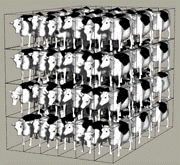Animal Science, Department of

World Congress on Genetics Applied to Livestock Production: 3rd (1986)
Date of this Version
1986
Abstract
Theoretical and practical ways to improve meat and milk production in the tropics by selection within local Bos indicus breeds, within Bos taurus x Bos indicus composite populations, upgrading of Bos indicus with Bos taurus breeds and though different crossbreeding programs have been discussed by various authors and summarized by Mason and Buvanendran (1982), Gregory et al. (1982) and Hickman (1979). Only few publications (Auriol, 1984; Chacko et al., 1985; Donegan and Roberts, 1984) exist on successful programs but numerous reports in developing agencies (FAO, 1985; SDC, 1985) indicate that many possibilities have been exploited and that various breeding programs in the tropics resulted in a considerable improvement of meat and/or milk production. The problem is that many reports are based on small numbers of animals kept under various conditions and observed over a short period. Main reasons for the realized improvement are generally crossbreeding programs which combine that adaptability of Bos indicus breeds to harsh environments, the production portential of the Bos taurus breeds and lead to large heterosis effects characteristic for Bos taurus x Bod indicus crosses. The problem of the appropriate breeding policy, the optimum Bos taurus inheritance in tropical cattle populations, the suitability of different Bos taurus breeds to be crossed with local zebu breeds have been discussed in a large number of reports (FAO, 1984; FAO, 1985; SDC, 1985) and publications, for example Meyn and Wilkins (1974, 1975), Mason (1974), Cunningham (1979, 1981) Frisch and Vercoe (1982), Hickman (1981), Cartwright (1982), Syrstad (1985) and many others. The main conclusion is that Bos taurus inheritance should not exceed 50 to 75%. In other words, the existance of genotype x environment interactions is generally accepted. There is no consensus about breeding policies and merits of different Bos taurus breeds for crossbreeding programs in the tropics.
The application of new techniques like artificial insemination, embryo transfer and eventually transgenic animals open new ways to improve milk and meat production in the tropics. For consultants involved in practical breeding programs, the choice of the appropriate breeding strategy will not become easier. In addition, more than in temperate countries, animal production in the tropics is generally not just a business, but rather part of a socio-economical and ecological complex.
In relation to the large number of contributions on possible breeding policies, there are only a few scientific publications in which tropical breeding programs are analyzed in retrospect (Acharya and Lush, 1968; Franklin et al., 1976; Baker and Morris, 1984).
The experience is that, in most situations, breeding strategies applied in temperate countries cannot be transferred to tropical conditions without modifications. The main reasons are:
- it is not possible to simply transfer Bos taurus breeds to the tropics because of climatic and health problems,
- the breeding objectives for cattle in the topics are often not identical with those in temperate countries and there is limited experience in selecting for these objectives,
- the infrastructure required for data recording and processing is often not available,
- due to a large number of more or less planned crossbreeding programs, a high proportion of the tropical cattle population consists of crossbred animals, and there is little experience in selecting within composites,
- genetic and physiological aspects in improvement of specific traits are not necessarily similar in the tropics as in temperate zones.
The purpose of this paper is to discuss some problems related to breeding programs for meat and/or milk production in the tropics, rather than results of well designed experiments. A few examples will be chosen to illustrate specific aspects. We chose them form out own involvement in tropical breeding programs or from well documented reports. Main emphasis is given to developing countries.


Comments
Published in 3rd World Congress on Genetics Applied to Livestock Production, edited by Gordon E. Dickerson and Rodger K. Johnson, 4 vols. (Lincoln: University of Nebraska Institute of Agriculture and Natural Resources, 1986). Copyright © 1986 Board of Regents University of Nebraska.